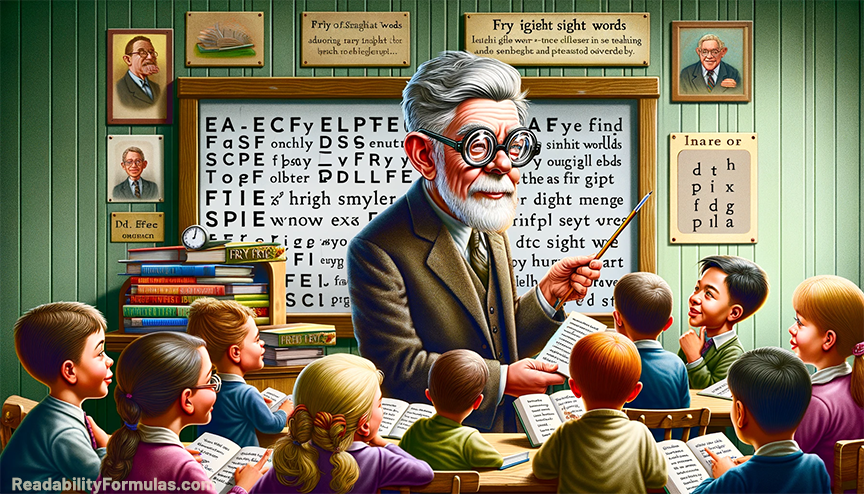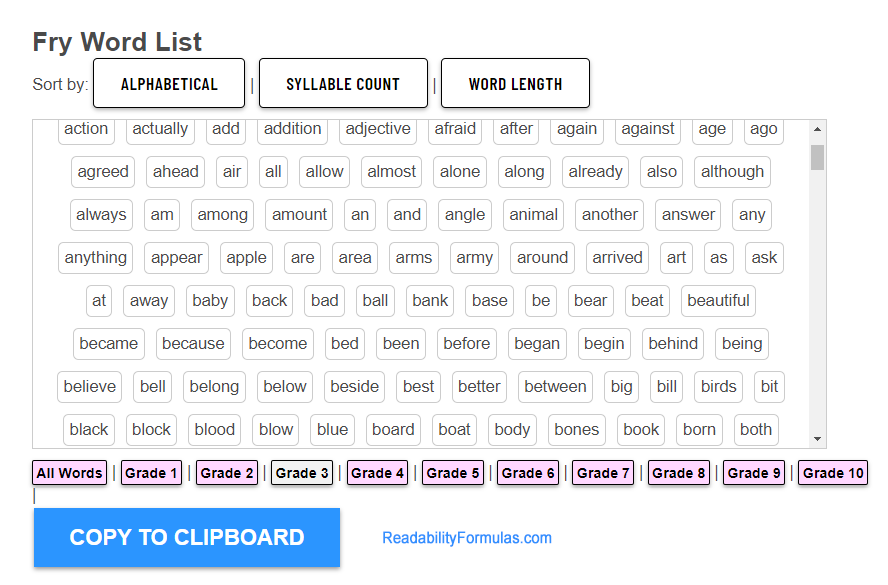 Reading is the gateway to knowledge and communication—it’s a fundamental skill children must acquire early in their educational journey. The initial path to this skill often winds through a landscape of common words known as “sight words,” which young learners are encouraged to recognize immediately without phonetic deciphering. Among the varied resources educators use, the Fry Sight Words—a compilation of the 1,000 most frequently used words in English—holds a significant place. Inspired by Dolch’s sight words, Dr. Edward Fry curated his own list to facilitate faster word recognition and thereby contribute to reading fluency.
Reading is the gateway to knowledge and communication—it’s a fundamental skill children must acquire early in their educational journey. The initial path to this skill often winds through a landscape of common words known as “sight words,” which young learners are encouraged to recognize immediately without phonetic deciphering. Among the varied resources educators use, the Fry Sight Words—a compilation of the 1,000 most frequently used words in English—holds a significant place. Inspired by Dolch’s sight words, Dr. Edward Fry curated his own list to facilitate faster word recognition and thereby contribute to reading fluency.
From the simple “the” to more complex prepositions, these words form the backbone of the English language as we use it daily. They are the stars in our linguistic galaxy, around which other words orbit, creating the constellations of our conversations and written texts. These words, it appears, serve as the silent majority in our texts, forming a vital part of our everyday lexicon. Recognizing them “on sight” helps young readers glide smoothly across sentences, facilitating comprehension and fluency.
The Fry Sight Words list is divided into 10 groups of 100. The first 300 words on the list comprise 67% of all words that children and adults use in their writing. The first 25 words are used in about one-third of all published texts. In kindergarten, teachers expect students to learn the first 100 sight words, which are the most frequently-used words in the English language. By mastering these words, children can recognize a significant portion of any text.
As students move up through the grades, teachers expect them to learn another set of 100 words each year. By the end of first grade, students should recognize the first 200 words; by the end of second grade, the first 300 words, and so on, up to the 1000 words by the end of 9th/10th grade.
Each sight word is a building block that improves reading speed, fluency, and comprehension. As they learn more words, students can read and understand more complex texts, which supports their learning in all subjects, not just English.
Because young readers can’t sound out sight words phonetically, recognizing them on sight eliminates the need to pause and decode each word. This leads to smoother, more efficient reading; it enables them to focus on word meaning rather than the mechanics of reading.
Education expert and former elementary school teacher, Dr. Nina Parrish, believes that “the key to teaching Fry Sight Words effectively lies in repetition and context. It’s not enough for children to merely memorize these words; they need to understand their usage within a sentence.” Parrish emphasizes using the words in sentence-building exercises, reading sessions, and even daily conversations to help cement the words in the students’ minds.
Key features about the Fry Sight Words:
- Frequency-Based: Fry’s list is organized by frequency, with the most commonly used words first. This means that children who learn these words early can read and understand a significant portion of any text.
- Focus on Recognition, not Phonetics: Sight words are typically not phonetic, which means young readers cannot sound them out. This is why sight words are taught in early education so that children can instantly recognize them.
- Graded Learning: Fry Sight Words are divided into groups of 100, splitting into lists of 50, for a total of 10 groups. These are usually taught from kindergarten through fifth grade, with the expectation that children should have mastered the first 100 words by the end of first grade, the second 100 words by the end of second grade, and so on.
- Foundation for Literacy: The mastery of these words is considered fundamental to literacy. As mentioned before, the first 300 words in the list account for about 67% of all the words students will encounter in their reading. A study from the National Assessment of Educational Progress (NAEP) revealed: “Students who failed to recognize even one of the ten most common sight words had significantly lower reading scores, underscoring the profound impact these words have on reading competence.”
- Used in Teaching Tools: Many educators use flash cards, word lists, games, and other resources to help students learn Fry sight words. These tools can help make learning these words fun and interactive.
To demonstrate the progression of sight word recognition and how it contributes to reading fluency, let’s follow a hypothetical student named Mia through her early reading stages:
Kindergarten: Basic Sight Word Recognition
- Sight Words Mia Learns:
the, and, you, it, of, in, was, he - Sentence: “The cat was in the box.”
- Explanation: Mia recognizes “the,” “was,” and “in” immediately, allowing her to focus on sounding out words like “cat” and “box.” This mix of sight words and phonetically decodable words gives her an initial experience of reading fluency.
First Grade: Expanding Sight Word Vocabulary
- New Sight Words Mia Learns:
that, they, but, with, she, at, this - Sentence: “She said that they played with the ball at the park.”
- Explanation: With a broader sight word vocabulary, Mia can quickly read most of the sentence, focusing primarily on unfamiliar or more complex words like “played” and “park.”
Second Grade: Greater Complexity and Fluency
- New Sight Words Mia Learns:
would, there, what, out, as, if, about - Sentence: “What would you do if there was a frog in your shoe?”
- Explanation: As Mia’s sight word bank expands, she can swiftly navigate longer sentences, pausing only occasionally to decode or sound out unfamiliar words.
Third Grade: Advanced Sentences and Comprehension
- New Sight Words Mia Learns:
because, before, which, does, other, any, their - Sentence: “Before you go to the other side, check which way the wind blows because it might affect your game.”
- Explanation: At this stage, Mia’s fluency is much improved. With a rich bank of sight words, her reading is smoother, and she can spend more cognitive energy on comprehension, understanding the context and meaning of the text.
Fourth Grade and Beyond: Mastery and Integration
- New Sight Words Mia Learns:
through, though, thought, enough, special, certain - Sentence: “Even though she thought the challenge was tough, she pushed through with enough determination to win the special prize.”
- Explanation: By now, Mia recognizes most common words in English texts immediately. This recognition, combined with her decoding skills, allows her to read complex sentences with ease, focusing on content comprehension and enjoying the narrative.
The progression from basic to advanced sight words—combined with increasing phonetic skills—equips readers like Mia to handle increasingly complex texts with confidence and understanding.
Fry Sight Words are not just beneficial to young readers, but they also provide a significant advantage to adult readers. Here’s how they can benefit both groups:
Young Readers
- Foundational Skills: Fry Sight Words equip young readers to recognize words without sounding them out, helping them progress in their reading abilities.
- Reading Fluency: By knowing these words on sight, children can read more smoothly and quickly, making the reading process less laborious and more enjoyable.
- Enhances Comprehension: Understanding these commonly used words lets children focus on the meaning of the text, rather than the mechanics of reading.
- Boosts Confidence: Successfully reading these words can lead to a sense of achievement, encouraging further reading and exploration.
- Tailored Learning: The Fry Sight Words list is divided into various levels, allowing educators and parents to target learning appropriately, creating a well-paced and customized learning pathway.
Adult Readers
- Literacy Development: For adults learning English as a second language or readers who struggle with literacy, the Fry Sight Words is essential to develop literacy skills.
- Comprehension and Speed: Similar to young readers, knowing these words enables adults to read more fluently and understand text more efficiently.
- Workplace Readiness: Many adult readers may need to strengthen their literacy for professional development. Mastery of these sight words can lead to improved communication skills, both in reading and writing, vital in many workplace settings.
- Supports Child’s Learning: Adults who know the importance of sight words can support their children’s learning, creating a more literate household.
- Further Education: For adults returning to education or pursuing career goals, knowing these sight words can help understand more complex studies.
Despite the wide adoption of Fry Sight Words, some critics argue that teaching phonics (the sounds letters make) before sight words is more beneficial. They claim that understanding the relationship between letters and sounds equips students with the tools to decode unfamiliar words, a skill sight words don’t provide.
As John Strucker, a specialist in adult literacy at Harvard Graduate School of Education, remarked, “Learning doesn’t have to be an ‘either-or’ situation. Sight words and phonics can complement each other in fostering literacy. Some words don’t follow phonetic rules and must be memorized, while phonics can be a useful tool for decoding new words.”
Overall, the Fry Sight Words methodology develops literacy and progressively enhances reading skills across grade levels.
At ReadabilityFormulas.com, you can use our Fry Sight 1000 Words tool to determine at which grade level students can understand your words.




